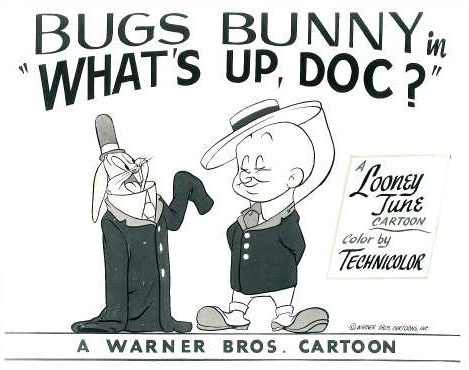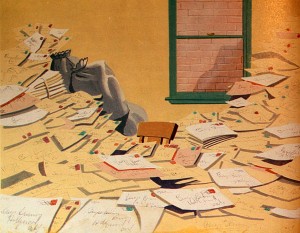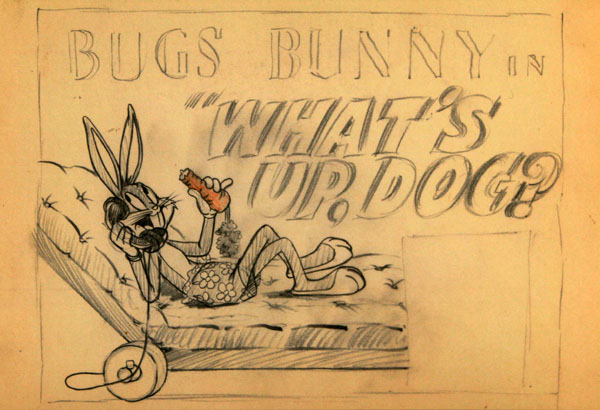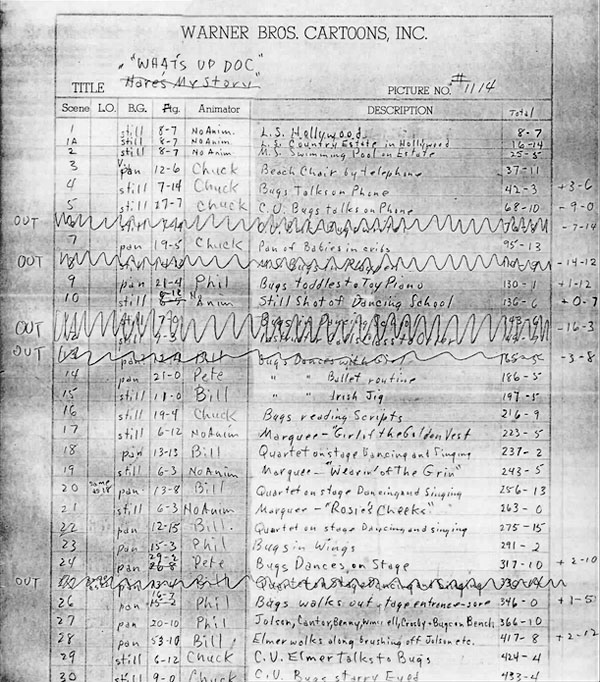
What’s Up Doc is an appropriate title for Bugs Bunny’s show business biopic, instead of its working title “Hare’s My Story,” given the phrase’s usage whenever Bugs is confronted by an adversary. It set the mark for his cavalier attitude when he first uttered those words, in his crystallized form, in Tex Avery’s A Wild Hare (1940). The phrase itself originated from Avery’s high school years in Dallas, when he and his classmates would greet each other as “Doc”.
 The song, “What’s Up, Doc,” which plays underneath the opening titles, and later sung by Bugs and Elmer near the end of the cartoon, had been introduced earlier in Stage Door Cartoon (1944) as a music cue underneath the main titles. It was used in two other instances, in Herr Meets Hare and The Unruly Hare, both released in 1945. As for the vocal performance, Bugs sang “What’s Up Doc” in a 1949 Capitol Record Reader Bugs Bunny in Storyland (written by Warners story-men Tedd Pierce and Warren Foster), issued a year before the cartoon’s release.
The song, “What’s Up, Doc,” which plays underneath the opening titles, and later sung by Bugs and Elmer near the end of the cartoon, had been introduced earlier in Stage Door Cartoon (1944) as a music cue underneath the main titles. It was used in two other instances, in Herr Meets Hare and The Unruly Hare, both released in 1945. As for the vocal performance, Bugs sang “What’s Up Doc” in a 1949 Capitol Record Reader Bugs Bunny in Storyland (written by Warners story-men Tedd Pierce and Warren Foster), issued a year before the cartoon’s release.
No records of the dialogue recording sessions exist for this cartoon, so it’s unclear if the song was first performed for the cartoon or for Capitol Records. Michael Ruppli’s research on Capitol Records revealed Mel Blanc overdubbed his vocal tracks for Storyland on April 21 and 22, 1949. In relation to the common 18-24 month gestation period from voice recording to the final product, it might be possible the performance for the cartoon occurred first—the dialogue recordings would have taken place around early or late 1948, based on the June 1950 release, but this is speculation, at best. Here’s the song from the Capitol Record Reader, as previously shared by Greg Ehrbar:
What’s Up, Doc would have been one of Scribner’s first cartoons for the McKimson unit, upon his return to the studio around 1948, after being hospitalized for tuberculosis three years earlier. Therefore, Scribner is given little footage—he is credited on the draft for the transitional shots of the train, which takes Bugs and Elmer to their next venue. He is only credited for one scene with character animation, of Bugs opening fan mail in scene 41.
 Emery Hawkins is also given no credit on the film, though he handles more vital material; he animates Bugs and Elmer’s vaudeville act, with Bugs bearing the brunt of Elmer’s pies and seltzer to the face, until he retaliates with the same, adding a mallet for good measure. (Deservedly so, since Bugs takes a seat in the baggage car, indicating Elmer’s stinginess to pay for extra train fare!) Hawkins also animates the wonderful performance of “What’s Up, Doc” from Bugs and Elmer on the Warner Bros. soundstage. Obviously, the difference between the Capitol Records and this cartoon’s rendition of the song is the duo’s transition to finish the song with a flourish—“We really mean it!”—in the manner of a showstopper in their vaudeville circuit.
Emery Hawkins is also given no credit on the film, though he handles more vital material; he animates Bugs and Elmer’s vaudeville act, with Bugs bearing the brunt of Elmer’s pies and seltzer to the face, until he retaliates with the same, adding a mallet for good measure. (Deservedly so, since Bugs takes a seat in the baggage car, indicating Elmer’s stinginess to pay for extra train fare!) Hawkins also animates the wonderful performance of “What’s Up, Doc” from Bugs and Elmer on the Warner Bros. soundstage. Obviously, the difference between the Capitol Records and this cartoon’s rendition of the song is the duo’s transition to finish the song with a flourish—“We really mean it!”—in the manner of a showstopper in their vaudeville circuit.
Bugs’ beginnings as a child prodigy mastering Franz Liszt on a toy piano, an exemplar student of Moray’s Dance Academy (named after Norman Moray, Warner Bros.’ executive in charge of the short subjects division), and finally appearing on hit Broadway productions, only to be relegated to the chorus, performing the same song in each show. Elements of Bugs’ venture into Broadway were certainly inspired by the 1952 MGM musical Singin’ in the Rain, besides its autobiographical “rise to the top” nature. In the film, during the “Broadway Melody” sequence, Don Lockwood (Gene Kelly) is portrayed as a guileless hoofer, first landing a job in a reclusive speakeasy, which results in performances in burlesque, then vaudeville and finally, the Ziegfeld Follies.

 Through each performance, the same lyrics are sung, (“When I hear that happy beat…feel like dancing down the street…”) Kelly’s change in costume through each venue is an optimistic one, whereas in McKimson’s cartoon, there is no such progression. Different screenplays for Singin’ in the Rain, as housed in the MGM files, were written between August 1950 and April 1951, after the release of What’s Up Doc, so it’s imaginable that screenwriters Betty Comden and Adolph Green—or other individuals involved with the production—were influenced by that moment of Bugs striving for stardom. Any film preceding What’s Up Doc, which used the gag, is no surprise, considering it was a stock routine at the time—it’s the staging that’s similar, in general. Here’s the sequence from the film:
Through each performance, the same lyrics are sung, (“When I hear that happy beat…feel like dancing down the street…”) Kelly’s change in costume through each venue is an optimistic one, whereas in McKimson’s cartoon, there is no such progression. Different screenplays for Singin’ in the Rain, as housed in the MGM files, were written between August 1950 and April 1951, after the release of What’s Up Doc, so it’s imaginable that screenwriters Betty Comden and Adolph Green—or other individuals involved with the production—were influenced by that moment of Bugs striving for stardom. Any film preceding What’s Up Doc, which used the gag, is no surprise, considering it was a stock routine at the time—it’s the staging that’s similar, in general. Here’s the sequence from the film:
The draft for What’s Up Doc ends with Hawkins’ musical finale of the titular song without the pay-off revealing Bugs’ first starring feature. There are several omissions from the cartoon, indicated on the draft—for instance, newspaper gossip columnist Walter Winchell was intended to be among the “out-of-work” actors (which include Al Jolson, Jack Benny, Eddie Cantor and Bing Crosby), outside at the park. Other sequences might have been cut for pacing, including a sequence of baby Bugs in his playpen, meant to be shown before he toddles over to his toy piano and Bugs dancing with a girl during his time at the dance academy. However these sequences would be achieved is up to interpretation, since storyboards of the Warners cartoons are scarce.
Oh, we’re the boys of the chorus
We hope you like our show
We know you’re rootin’ for us
But now we have to go-o-o-o-o-o-o…



(Thanks to Michael Barrier and Frank Young for their help.)
PostScript: I don’t know how we can do a post about Robert McKimson’s What’s Up Doc? (1950) without including a clip of its cameo appearance in Peter Bogdanovich’s What’s Up, Doc? (1972)…


 DEVON BAXTER is a film restoration artist, video editor, and animation researcher/writer currently residing in Pennsylvania. He also hosts a
DEVON BAXTER is a film restoration artist, video editor, and animation researcher/writer currently residing in Pennsylvania. He also hosts a 





















































































This also seems to have been the cartoon where McKimson gave up his Jean Blanchard-drawn ‘Chubby Bugs” model sheet and went back to the slimmer design that was more in line with the Freleng and Jones units, and what McKimson had been animating under Bob Clampett (must have been all that chorus dancing that caused Bugs to lose weight….)
I remember the scene where Elmer Fudd was a big time Vaudeville star and the “bum” that were hanging out of the park with a “down and out” Bugs were based on real Radio and Movie stars at the time (Jack Benny,Eddie Cantor and Bing Crosby) before Elmer discovers Bugs and offers him in his Vaudeville show.
Did the Sportsmen Quartet (who performed on Jack Benny’s show) do the vocals for “the boys in the chorus”?
Good work again, Devon. Worth noting the Sportsmen quartet did the fine chorus vocalizing. That is confirmed from a note in some of Stalling’s papers and passed on to me via Dan Goldmark. Not sure if it’s Dave Barry as a couple of celebrities, but Mel does Cantor.
That answers my question – I figured they were either the Sportsmen or the King’s Men, but after hearing more of them in old Benny episodes, I was leaning toward the former.
I’m curious about the bit in the middle, when Bugs gets his big break onstage only to be greeted by the sound of crickets chirping (if it were dead silence, the audience would think there was a problem with the audio, but the crickets make it funny).
Where did this gag first appear? Seems tailor-made for cartoons, and it’s so iconic that nowadays, you only have to add the word “Crickets” after quoting someone’s statement, meaning “that was so harebrained that it would obviously be greeted with stunned silence”.
PS I see in the draft that originally the chorus was supposed to come back and do their thing after Bugs’ act bombs – unless this is a mistake, could it mean that the “crickets” gag was dreamed up later in a moment of high inspiration?
PPS Credit is also due to croaking frogs.
Curious, but was Arthur Q. Bryan credited for the voice of Elmer Fudd on that record?
One of Bob McKimson’s best efforts. Bob was a underrated cartoon director.
“We’re the boys of chorus” can be heard every week at the end of Svengoolie. Rich Koz is clearly a Looney Tunes fan.
Emery Hawkins and Pete Burness provided my favorite animation in this short. A shame neither would be in McKimson’s unit for very long.
This cartoon features one of Carl Stalling’s finest soundtracks. So many cues packed into only seven minutes: http://www.imdb.com/title/tt0043128/soundtrack
Favorite dialog:
“I give up, Mr. Fudd. Why is the state of Ohio different?”
“Because it’s high in the middle and round on both ends! O-high-OH! (pie in the face) Yuk yuk yuk yuk yuk!”
The “What’s Up Doc” record gets played by the young son of Doris Day’s character in My Dream Is Yours, the 1949 WB musical with a Bugs Bunny dream sequence directed by Freleng.
Thanks so much for this. Growing up I considered this my favourite short in the Saturday morning rotation. (In hindsight it must have been a preference for McKimson because Hot Cross Bunny was another favourite, though that one was in the local syndication package at the time.) It was a shame how the network censors hacked up the scene where Bugs gets his onstage revenge on Fudd.